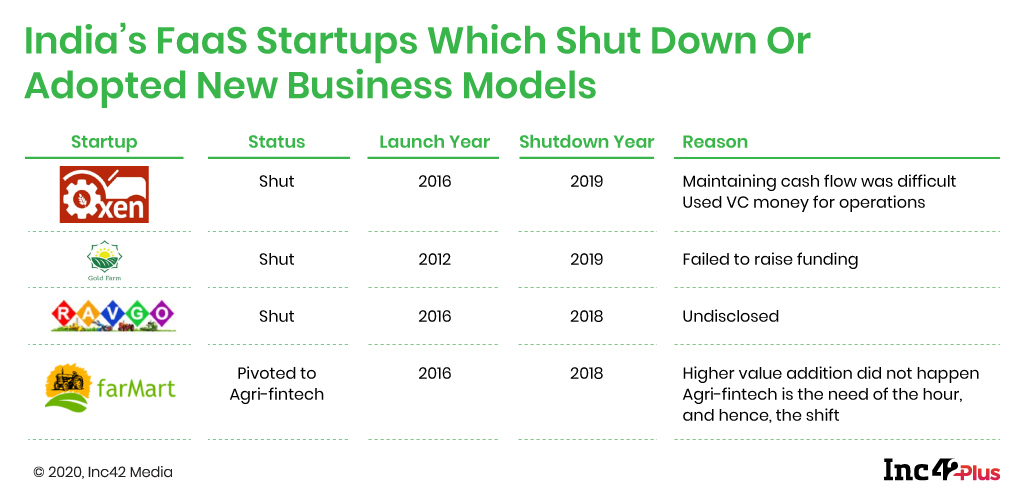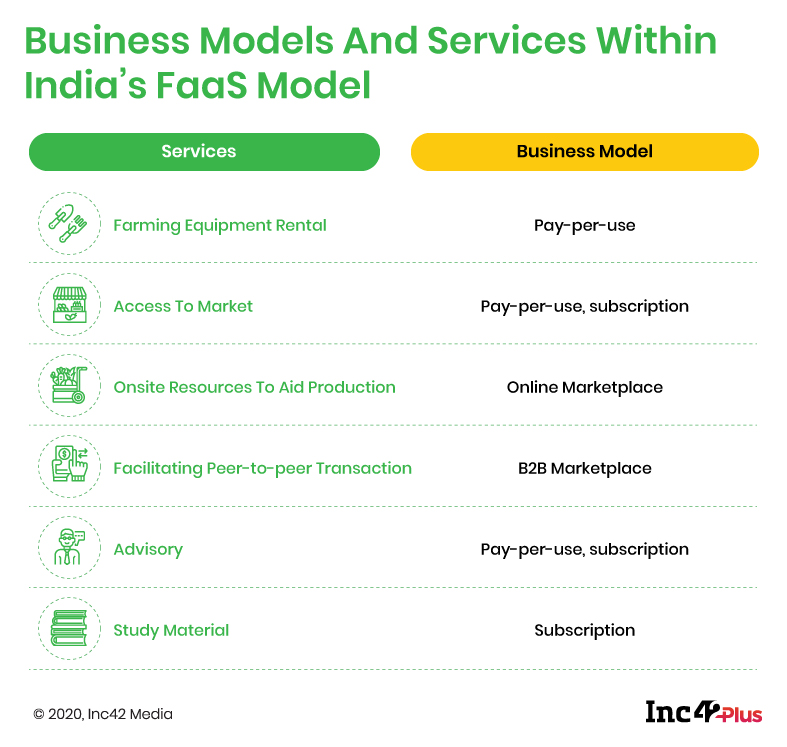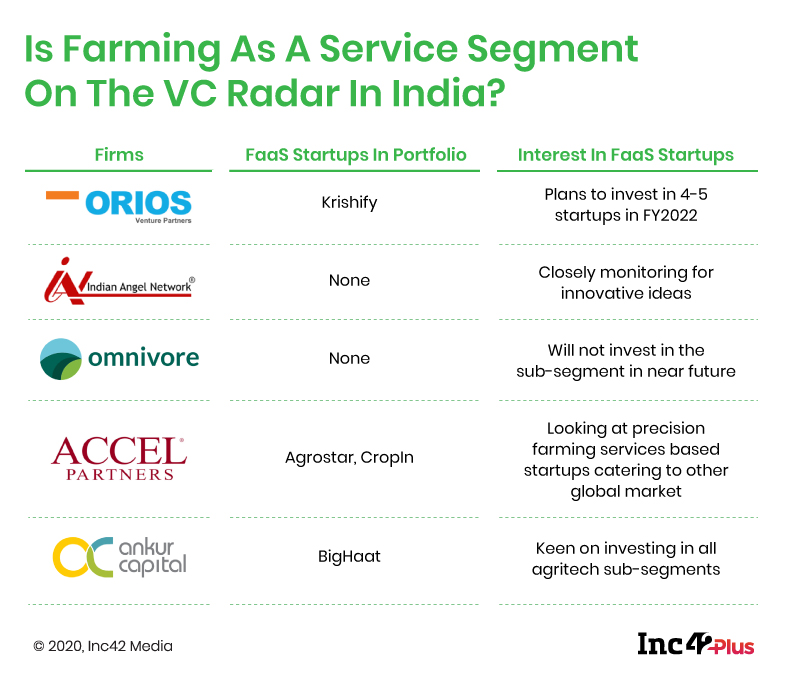SUMMARY
Startups operating in the farming as a service (FaaS) sub-segment address pain points across the supply chain such as lack of farm mechanisation, absence of crop advisory and farmers’ inability to reach markets or reach out to market-linkage startups
While some startups in the space such as EM3 and BigHaat have achieved scale, many, including Oxen Farm Solutions and Gold Farm, have shut shop. Is the asset-heavy model to be blamed?
Equipment rental as a standalone model may not work for all; creating parallel revenue streams would be a smarter choice, say venture capitalists who are closely watching the space
Farming 3.0: India’s Mission Agritech
Once least favoured, agritech is today betted as one of the most resilient sectors. The pandemic has further pushed farmers to leverage technology offered by the startups in the space, thereby making the sector a hotspot of investments. Is India’s agritech on the brink of a permanent transformation or the newly-found success a passing cloud? This playbook explores!
For 52-year-old Shailendra Singh, a small farmer residing in the Keshouri village in Bihar’s Nawada district, the biggest challenge in his profession was uncertainty. Not just uncertain weather conditions that could impact his crops but something as essential as getting a tractor on time before it would be too late to plough.
Singh had been saving a little money every year but not enough to fund a tractor. Finding the workforce to operate the machine was also an expensive and tedious affair. So, he had to depend on local agents to rent one, along with operators. The downside: There was never a guarantee that the tractor would reach his farm on time. “Two years ago, I got the tractor five days later than scheduled. By then, the land was not worth ploughing and I had a loss of around INR 20K,” he recalls.
The scenario has improved today. Singh still gets a tractor on rent, but now he knows there will be no delay. The reason: he no longer depends on local agents from the unorganised renting sector; he rents it from Agrix, an early-stage startup that guarantees timely delivery and an expert driver to do the job. The farmer is still not familiar with the operations, but he can easily reach out to the company’s village representative for any help in terms of payment and booking.
Just like Singh, many farmers across various Indian states are reaching out to agritech startups which rent tractors, ground-leveling and deep-ploughing equipment and power harrows. Startups operating in the Farming-as-a-Service (FaaS) sub-segment include the likes of EM3 Agri Services, BigHaat and Krishify, and they have been addressing the inefficiencies across the supply chain, including lack of farm mechanisation, crop advisory and access to markets.
They also bring different stakeholders, including small and large farmers, local representatives, vendors and agricultural experts, under one umbrella so that unorganised operations could be streamlined and the business of farming would be profitable.
“Two things that farmers cannot move under the services segment are land and crops. Everything else can become a service. Take, for instance, cattle trading, where farmers usually go to melas and buy cattle. Almost every farmer owns draft animals/livestock and the buying and selling are often carried out by people in the traditional manner. But not anymore; startups are changing that. They have created a service through which you can list, sell and buy. This is just one example of many services which are emerging,” says Rehan Yar Khan, managing partner at Orios Venture Partners.
The VC fund has invested in Delhi-NCR-based Krishify, which claims to have 1.5 Mn farmers on its platform. Orios is also planning to invest in three-four startups in this space.
According to a 2018 report by BAIN & Company, FaaS has a lot of potential and India has seen a rise in the number of startups and an influx of funds into the sector. “Total investor funding for FaaS in India is currently $105 Mn to $115 Mn. More than 40% of funding rounds are at a series stage, indicating investors’ high level of confidence in investing more money in the growth stage. Further, the number of startups evolving to growth-stage funding has increased as investors become more confident in the viability of these business models and the returns,” the report states.

Most of these startups claim to bring down farmers’ labour costs by 50% or so as they leverage tech and sector expertise to convert fixed upfront costs into variable ongoing costs. Their aim is to reduce the farmers’ financial burden, but how viable are these businesses?
On the one hand, there are growth-stage and late-stage startups such as EM3, BigHaat and Ujjay, which are growing steadily, while seed-stage startups like Agrix claim to see tremendous opportunities here. In stark contrast, startups such as Oxen Farms Solutions, Gold Farm and Ravgo had shut shop in the past five years.
Is Uber Or Ola-For-Farmers An Asset-heavy Model?
Services in this space fall under two broad categories: First, where demand existed before agri startups started offering their services and second, where startups created the demand. Farm mechanisation comes under the first, and that is why it is a mature business model. Most of the startups in this space have adopted mechanisation as the core model, explains Santosh Kumar Singh, director, agriculture, energy and climate change, at Intellecap.
Under farm mechanisation, the most mature and popular sub-segment within FaaS, a whole range of smaller equipment such as power and battery sprayers, manual seeders, seedling transplanters, cutting saws, fruit pickers and garden hand tools are rented to farmers and home-delivered for convenience. As for expensive equipment like tractors, most companies offer pay-per-use rentals or the Uber-for-tractors model, as it is popularly called.
The farm mechanisation level in India is quite low (40-45%) compared to other countries such as the US (95%), Brazil (75%) and China (57%) as it requires significant investments. Also, most of these high-value equipments are used four or five times a year, and hence, the return on investment is low. Consequently, most small and marginal farmers heavily depend on local agents for equipment rental. As this sector is highly unorganised, the cost is not uniform either, and a lot of the farm machinery on hire is overpriced. At times, the right kind of equipment is not used for a specific type of land, and quite often, farm machinery is not delivered on time.
Startups in this space either buy the tractors, tube wells, seed drills, supersedes and multure machines or rent these from large farmers.
“The algorithm created by them helps them predict the demand for tractors and facilitate the renting process. The software is also used to map the soil and advise equipment accordingly,” says Nilay Pandey, cofounder, Agrix.
As soon as farmers realised that it would not make sense economically to buy tractors (and other large and expensive machinery), original equipment manufacturers (OEMs) started facing demand-side challenges and decided to work on new business models. Mahindra & Mahindra launched a tractor rental service startup called TRRINGO in 2016 and invested around INR 10 Cr in the new business. Similarly, OEM John Deere partnered with EM3 in 2017. Other startups also came into the play and bought or rented equipment from OEMs and in some cases, from local agents.
The business model here is asset-heavy. By aggregating the demand and utilising the assets to the maximum, startups can provide attractive value propositions to farmers, says Intellecap’s Singh. “Startups aggregate the demand and engage tractors for various activities throughout the year, unlike traditional agents who only rent it to farmers four times a year as they are not able to predict the demand for other activities,” he explains. For instance, a tractor can also be used for transportation or pulling other farm equipment.
Additionally, each startup caters to a minimum of 3-20 villages, unlike unorganised rental businesses where word-of-mouth is the only way to establish demand.
“It is like the business of taxi. You can get one customer all day, and the economics will be different and you will not be able to deploy the full potential of the taxi. The same thing applies here. The more they use, the more favourable the economics becomes,” notes Santosh Kumar Singh, director, agriculture, energy and climate change, Intellecap.
Its economics only works when you are serving a lot of farmers and when you are using the machinery throughout the year, says Pandey of Agrix. The same applies to other machines such as solar pumps or harvesters, which are shared by many farmers.
Why Some Startups Have Shut Shop
At the outset, the machinery-sharing model looks scalable just like the business of Ola or Uber. But the outcomes are not in sync. As mentioned before, Oxen Farm Solutions, Gold Farm and Ravgo have already shut down. farMart has pivoted and launched a marketing app for agricultural merchants, sending updates about inventories, new products, crop advisory and end-of-season stock-clearing discounts.
“We could not raise the next round of funding,” rues Vishwajeet Sinha, CEO of Oxen Farm Solutions. “Within farm mechanisation, we tried many models and realised that harvesting is the only service where the cash flow issue is at a minimum. When a farmer harvests a crop, it gets sold, and he gets the money in 15 days or so. But cash flow only happens during the two harvest seasons and when government subsidies come in. For others like market-linkage startups, it is a daily cash cycle,” he explains.
Using the VC money as working capital also became a challenge. All these issues cropped up in spite of its effort to focus on combine harvesters and reaching out to 15,000 farmers in two-three states within two years of starting up.

Agritech startup farMart also pivoted to agri fintech and other services within two years of launching as the company realised it was not a feasible model to work on.
“A bunch of companies, along with us, have shut shop or pivoted for two reasons. One, farmers were not aware of tech. Two, we realised that most of the farmers did not have access to instant finance and that is where the market gap is. So, now we provide agri inputs on credit,” says Alekh Sanghera, cofounder, farMart.
Another key reason behind such business failures is the unorganised ecosystem. It makes things difficult for many startups which do not understand the challenges at the grassroots. For instance, if they fail to convince a farmer about the benefits of choosing them over traditional agents, they will fail to increase the number of users and the usage of their machinery.
“It is important to understand that FaaS already exists as a strong informal service within the agri ecosystem in India. So, we need to approach it differently. Instead of building a business exclusively around FaaS, adding it as one of the services on a large farmer-focussed platform like DeHaat would help FaaS grow better,” says Mark Kahn, managing partner, Omnivore.
That is why we see only a few success stories in the equipment rental space under FaaS. And EM3 Agri Services is one of them. Set up in 2013, the startup raised $3.3 Mn in Series A funding from Aspada within two years. Or take TRRINGO, for instance, that caters to more than 100K farmers.
Interestingly, even EM3 had to pivot slightly to make things work. According to the Hohenheim Working Papers on ‘social and institutional change in agricultural development 2001-2020’, accessed by Inc42, the company initially operated custom hire centres with its own machines. But this approach was later replaced by an asset-light strategy. In the current franchise model, franchisees own the machines and EM3 provides support functions like providing know-how and acquiring customers. The franchisees pay 5% of every transaction to EM3 every month.
According to VCs, equipment rental as a standalone model may not be viable, and that is why various elements get added to the core service.
“In India, if there is a lot of hardware which needs to be deployed, it is not scalable,” says Prashanth Prakash, partner, Accel, which has invested in AgroStar.
A significant part of the supply chain value lies in the trade, notes Rema Subramanian, cofounder and managing partner of Ankur Capital. “We see the need for trade and it must be an integral part of the business model for extracting value and scale. Apart from boosting the revenue stream, trade also becomes an anchor or a hook for retaining stakeholders. So, rentals and advisory may not be enough for a long-term, scalable proposition,” she says, adding that her firm will continue to invest in supply chains, both forward and backward links.
Startups Are Exploring Many Elements Of FaaS
Unlike other segments such as market-linkage platforms which are consumer-focussed or agri inputs startups which provide drones to large farmers, FaaS startups work for small and marginal farmers. So, they need ancillary or multiple models to achieve business viability. According to Padmaja Ruparel, cofounder of Indian Angel Network (IAN), startups like EM3 have ushered in a great platform play, but it could be a little capex-heavy if one fails to achieve scale. That is why a lot of innovations are seen in this segment; these ensure additional, value-added services.
“Many companies are introducing technologies such as artificial intelligence (AI) and machine learning (ML) to ensure that the capex is brought down. And this movement towards tech is happening faster than I expected,” says Ruparel. Plus, this is one sector that has seen numerous innovations and massive funding.
“The number of FaaS startups have doubled in the past five or six years. We see three times more focus in this space,” she notes. According to Ruparel, different models emerging in upstream and downstream services are now scalable, and there is a huge opportunity in infra-sharing.
Current production benchmarks in India are so low that any timely assistance, even without a lot of technology, and access to the right information at the right intervention provide dramatic improvements in production, adds Prakash of Accel.

Learning from the failure of startups which focussed on mechanisation, FaaS businesses have started to deliver solutions across the supply chain. It begins with delivering services for pre-harvests while startups such as Krishify mostly provide advisory on best crops and insuring against calamities. Some startups connect farmers to marketplaces for buying seeds and other essential items for agri production and charge a commission on the same. Again, a few offer vernacular-language online marketplaces with focus on sowing necessities.
BigHaat, for instance, not only disseminates advisory using crop science and data science but has also partnered with vendors, including Fito, Namdhari and Monsanto, among others, to sell the best suitable inputs. Set up in 2015, the startup has raised more than $2 Mn in pre-Series A in August 2020 from Ankur Capital and is currently operating at a profit margin of 5-20%. Monetisation in this model is based on commissions from retail vendors and subscriptions from farmers.
Hyderabad-based Ujjay, a bootstrapped company, serves more than 200,000 farmers and provides data analytics, crop marketing and value chain traceability besides mechanisation. Ditto for Agrix whose overall profit margins stand at 8-15%. The company caters to 4,000 farmers and provides several services along with rentals. Ujjay claims that only 10% of its operational cost goes into customer acquisition.
Organised knowledge-sharing is also crucial and startups in this space are enabling the same. “We created a community where progressive farmers who have cracked different aspects can pass on the knowledge to others. We have simplified the process. They post images and videos and report issues such as pests. Our experts respond with solutions and other farmers also pitch in,” says Rajesh Ranjan, cofounder of Krishify.
Founded in 2019, the Gurugram-based startup has 1.5 Mn farmers on its platform that offers content in Hindi for farmers in Punjab, Haryana, Uttar Pradesh, Jharkhand, Bihar and Maharashtra. The experts on board are mostly experienced professors from agricultural universities. Additionally, the company facilitates peer-to-peer transactions between farmers.
“Experience farmers usually grow their hybrid varieties and sell the seeds to small farmers. They are farmer-microentrepreneurs who find it difficult to reach out to other farmers. So, we have given them a platform to sell while small farmers get a platform to buy the best seeds,” adds Ranjan.
Finally comes market access where they play a crucial role. “As we work closely with farmers on the upstream, we have key data that helps us connect the right farmers to the right market-linkage startups,” says Sateesh Nukala, CEO and cofounder of BigHaat.
The likes of Ninjacart and WayCool also operate collection centres and provide vehicles like e-rickshaws to help farmers bring their produce to these collection centres. Some startups also offer free services (alerts on weather conditions, information on agricultural policies in vernacular languages) to get more farmers onto their platforms and turn them into subscribers of paid services.
Resistance To Tech, Varied Landscape And Other Challenges
The need to build multiple revenue streams is crucial for startup success. But these young companies also face quite a few smaller challenges. One is bound to come across farmers who do not know the efficient usage of a smartphone or do not trust online transactions. As a result, startups have to arrange for representatives who can visit farms, take photographs of samples and post them, and also help farmers with digital payments. Understandably, this an additional cost burden.
Bad deployment also hampers business continuity. “We have to wait for 14 days to get tractors on rent. That is the level of disparity in mechanisation in our villages. So, we need to plan early on,” says Pandey of Agrix whose company works in more than 20 villages in Bihar.
Another major roadblock is caused by multiple agricultural pockets due to widely varying climatic conditions. Unlike other countries, the climate, soil, crop and other factors vary every 20 km. Language, too, becomes a crucial factor as most locals speak one language or one dialect within a specific area. Thus, bringing everyone on a common platform may not be feasible until startups can achieve a certain scale and manage to communicate in major vernacular languages. As of now, startups operate in niche pockets.
VCs Pin Hopes On Farmer-Led Startups, More Innovations
Although Omnivore does not plan to invest in agritech startups focussing exclusively on FaaS, several investors, including Orios Venture Partners, IAN and Accel, are keeping a close watch and open to investments, provided innovations can bring in scale.
“Revenue from one activity may not justify the kind of investments people have made. Also, one’s main customer base requires five-six services; so one has to provide all of them. In fact, the more you integrate, the more the demand. Startups are trying to be a one-stop solution to make business sense,” says Mark Kahn of Omnivore.
Since FaaS as a model requires a lot of understanding about farming and the families on the ground, investors are more welcoming to founders who have a thorough knowledge of what happens at the grassroots. “We are always keen on founders who understand what is happening on the ground and also understand tech. So, we would prefer them over those who can only give tech solutions,” adds Kahn.

Ruparel of IAN elaborates it further. According to her, understanding the community is extremely important where farmers are engaged. “You do not need it if you are in, say, biotech. But in this case, if one of the founders has done an agriculture course or comes from a farming family, he/she will always have an edge,” she points out. Then she speaks about semi-urban or semi-rural areas where the father is a farmer, and the son or daughter has moved out and done a technology course, which will be an exciting combination. “They can bring the best of both worlds,” she adds.
Kahn, however, thinks that the adoption of FaaS at the grassroots level should not be an issue as it is already there to some extent. Think of mechanisation. Tractors are available on rent in most Indian villages and agri-entrepreneurs rent their combine harvesters across farming belts all season long. “What needs work is driving the adoption of the formal version. Instead of looking at changing FaaS, the focus should be on finding better strategies to ensure farmer adoption,” he notes.
In brief, more innovations, multiple revenue streams and unique business strategies are likely to make the FaaS startups sustainable, feel the VCs. Integrating it with already existing models such as agri inputs could also be an interesting proposition.
Sinha of Oxen leaves us with another insight from his entrepreneurial journey. “Some startups are trying a fixed geographical base model. But their solutions will face climate risks, and they have to provide other services or target other segments like horticulture to stay sustainable,” he says.



























